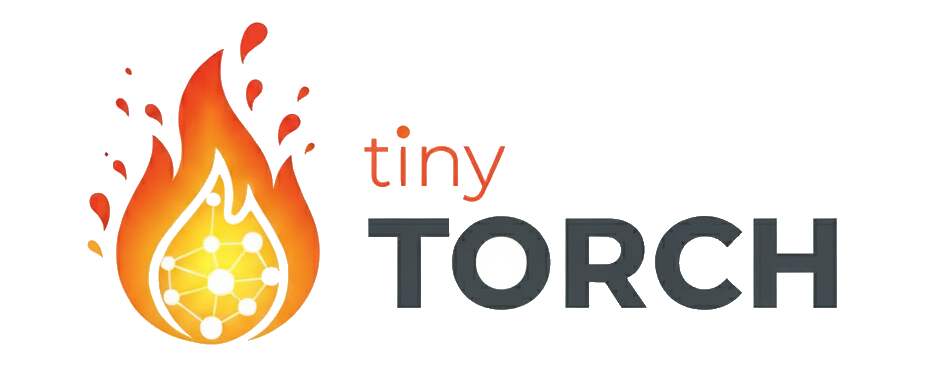Module: Setup#
⭐ | ⏱️ 1-2 hours
📊 Module Info#
Difficulty: ⭐ Beginner
Time Estimate: 1-2 hours
Prerequisites: Basic Python knowledge
Next Steps: Tensor module
Welcome to TinyTorch! This foundational module introduces the complete development workflow that powers every subsequent module. You’ll master the nbdev notebook-to-Python workflow, implement your first TinyTorch components, and establish the coding patterns used throughout the entire course.
🎯 Learning Objectives#
By the end of this module, you will be able to:
Master the nbdev workflow: Write code with
#| exportdirectives and understand the notebook-to-package pipelineImplement system utilities: Build functions for system information collection and developer profiles
Use TinyTorch CLI tools: Run tests, sync modules, and check development progress
Write production-ready code: Follow professional patterns for error handling, testing, and documentation
Establish development rhythm: Understand the build → test → iterate cycle that drives all TinyTorch modules
🧠 Build → Use → Reflect#
This module follows TinyTorch’s Build → Use → Reflect framework:
Build: Implement core utilities (hello functions, system info, developer profiles)
Use: Apply these components in real development workflows and testing scenarios
Master: Understand how this foundation supports all advanced TinyTorch modules and establish professional development habits
📚 What You’ll Build#
Core Functions#
# Welcome and basic operations
hello_tinytorch() # ASCII art and course introduction
add_numbers(2, 3) # Foundation arithmetic operations
# System information utilities
info = SystemInfo()
print(f"Platform: {info.platform}")
print(f"Compatible: {info.is_compatible()}")
# Developer profile management
profile = DeveloperProfile(name="Your Name", affiliation="University")
print(profile.get_full_profile())
System Information Class#
Platform detection: Python version, operating system, machine architecture
Compatibility checking: Verify minimum requirements for TinyTorch development
Environment validation: Ensure proper setup for course progression
Developer Profile Class#
Personalized signatures: Professional code attribution and contact information
ASCII art integration: Custom flame art loading with graceful fallbacks
Educational customization: Personalize your TinyTorch learning experience
🚀 Getting Started#
Prerequisites#
Ensure you have completed the TinyTorch installation and environment setup:
# Activate TinyTorch environment
source bin/activate-tinytorch.sh
# Verify installation
tito doctor
Development Workflow#
Open the development notebook:
modules/source/01_setup/setup_dev.pyFollow the guided implementation: Complete TODO sections with provided scaffolding
Export your code:
tito export --module setupTest your implementation:
tito test --module setupVerify integration:
tito nbdev buildto ensure package compatibility
🧪 Testing Your Implementation#
Comprehensive Test Suite#
Run the full test suite to verify your implementation:
# TinyTorch CLI (recommended)
tito test --module setup
# Direct pytest execution
python -m pytest tests/ -k setup -v
Test Coverage (20 Tests)#
✅ Function execution: All functions run without errors
✅ Output validation: Correct content and formatting
✅ Arithmetic operations: Basic, negative, and floating-point math
✅ System information: Platform detection and compatibility
✅ Developer profiles: Default and custom configurations
✅ ASCII art handling: File loading and fallback behavior
✅ Error recovery: Graceful handling of missing files
✅ Integration testing: All components work together
Inline Testing#
The module includes educational inline tests that run during development:
# Example inline test output
🔬 Unit Test: SystemInfo functionality...
✅ System detection works
✅ Compatibility checking works
📈 Progress: SystemInfo ✓
🎯 Key Concepts#
Real-World Applications#
Development Environment Management: Like PyTorch’s system compatibility checking
Professional Code Attribution: Similar to open-source project contributor systems
Educational Scaffolding: Mirrors industry onboarding and training workflows
System Validation: Foundation for deployment compatibility (used in modules 12-14)
Core Programming Patterns#
NBDev Integration: Write once in notebooks, deploy everywhere as Python packages
Export Directives: Strategic use of
#| exportfor clean package structureError Handling: Graceful fallbacks for missing resources and system incompatibilities
Object-Oriented Design: Classes with clear responsibilities and professional interfaces
Testing Philosophy: Comprehensive coverage with both unit and integration approaches
TinyTorch Foundation#
This module establishes patterns used throughout the course:
Module → Package Mapping:
setup_dev.py→tinytorch.core.setupDevelopment Workflow: Edit → Export → Test → Iterate cycle
Educational Structure: Guided implementation with instructor solutions
Professional Standards: Production-ready code with full test coverage
🎉 Ready to Build?#
You’re about to establish the foundation that will power your entire TinyTorch journey! This module teaches the development workflow mastery that professional ML engineers use daily.
Every advanced concept you’ll learn - from tensors to optimizers to MLOps - builds on the solid patterns you’re about to implement here. Take your time, test thoroughly, and enjoy building something that really works!
Choose your preferred way to engage with this module:
Run this module interactively in your browser. No installation required!
Use Google Colab for GPU access and cloud compute power.
Browse the Python source code and understand the implementation.
💾 Save Your Progress
Binder sessions are temporary! Download your completed notebook when done, or switch to local development for persistent work.
